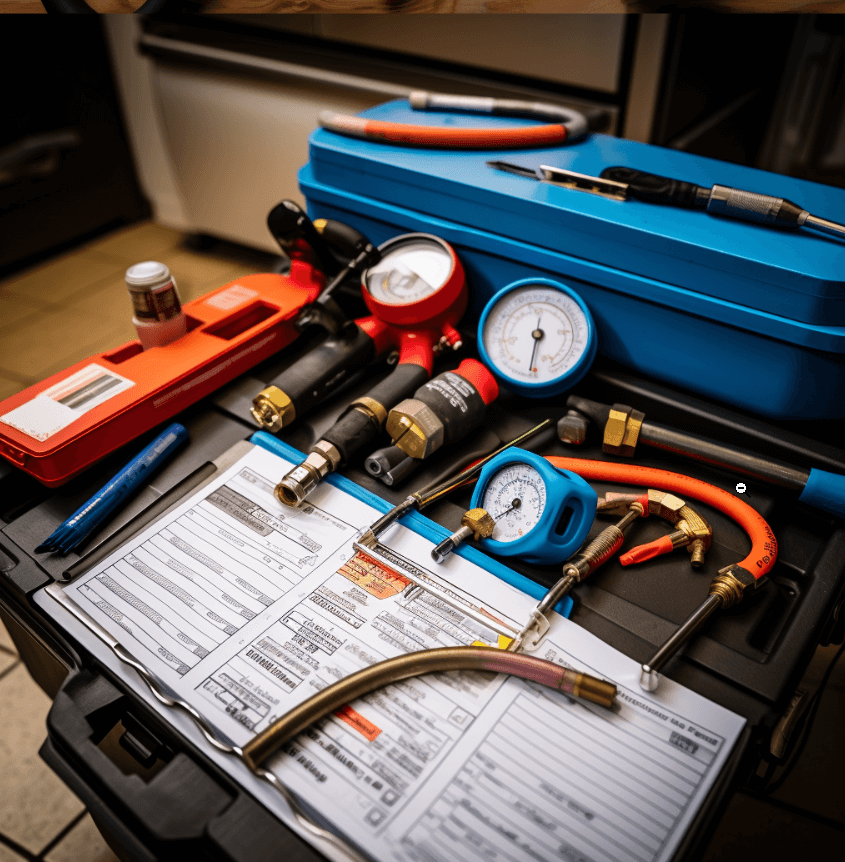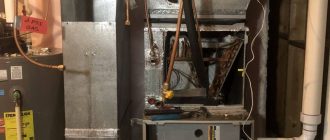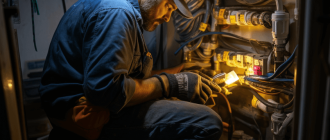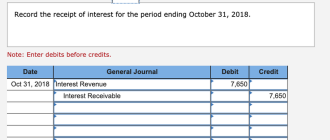Diagnostic Fee, Service Fee, Trip Charge: Which One?

Unlocking the mystery behind HVAC fees can feel like deciphering a complex code. From diagnostic fees to service charges and trip expenses, understanding the purpose and differences between these fees is crucial for both customers and service providers in the heating, ventilation, and air conditioning industry. In this blog post, we’ll break down each fee, explore common scenarios for charging them, discuss factors influencing fee structures, and provide tips on communicating pricing to customers effectively. So let’s dive into the world of diagnostic fees, service fees, and trip charges – demystifying these terms one step at a time!
Understanding Diagnostic Fee
When your HVAC system is on the fritz, it’s natural to call in a professional for help. But what exactly does that initial diagnostic fee cover? Well, think of it as the price you pay for an expert technician to identify the root cause of your HVAC problem.
The diagnostic fee typically includes thorough troubleshooting and examination of your heating or cooling system. This involves inspecting various components, running diagnostics tests, and analyzing data to pinpoint the issue. It requires specialized knowledge and expertise – after all, these technicians have spent years honing their skills.
So why charge a separate fee just for diagnosis? The answer lies in transparency and fairness. By clearly delineating this cost upfront, HVAC companies ensure that customers understand they are paying for valuable expertise and time spent diagnosing the problem accurately.
It’s worth noting that not all HVAC companies charge a separate diagnostic fee. Some may include it as part of their service package or offer waived fees if repairs are performed through them. Understanding whether there is a diagnostic fee involved before scheduling an appointment can help avoid any surprises when receiving the final bill.
Remember, a comprehensive diagnosis sets the stage for efficient repairs by addressing underlying issues rather than simply treating symptoms. So while it might be tempting to skip out on this step to save some money initially, investing in this essential assessment ensures long-term solutions and helps prevent recurring problems down the line.
Stay tuned as we delve into service fees next – another important aspect of understanding pricing structures within the realm of HVAC services!
Exploring Service Fee
When it comes to hiring HVAC professionals for repairs or maintenance services, you may come across a service fee. But what exactly does this fee entail? Let’s explore!
The service fee is typically charged by HVAC companies as compensation for their time and expertise in diagnosing the issue with your system. It covers the cost of sending out a technician to assess the problem and provide recommendations.
One important thing to note is that the service fee is separate from any additional charges for parts or labor required to fix the problem. The purpose of this fee is solely to cover the initial assessment and diagnosis.
The amount of the service fee can vary depending on several factors, including location, company policies, and complexity of the issue at hand. It’s essential for HVAC companies to set competitive yet fair pricing structures that align with industry standards.
So when should you expect a service fee? Generally, if you call an HVAC company for a specific repair request or when your system isn’t functioning correctly, they may charge a service fee upfront before any work begins.
By charging a nominal service fee upfront, reputable HVAC companies ensure that customers understand there will be costs associated with diagnosing issues but also demonstrate transparency in their pricing structure.
Remember, this initial evaluation allows technicians to determine precisely what needs fixing so they can give accurate estimates for repairs or replacement parts needed. This clarity benefits both parties involved – customers can make informed decisions about proceeding with further repairs while establishing trust between them and the HVAC provider.
Stay tuned as we delve into other fees commonly encountered within the industry!
Deciphering Trip Charge
When it comes to HVAC services, understanding the various fees can sometimes feel like deciphering a secret code. One fee that often leaves customers scratching their heads is the trip charge. So, what exactly is a trip charge and why is it important to know about it?
A trip charge is a fee that HVAC companies typically charge for the technician’s travel expenses to your location. Think of it as compensation for their time and resources spent getting to your doorstep. This fee helps cover fuel costs, vehicle maintenance, and the technician’s valuable time.
But how do you determine if a trip charge applies in your situation? Well, typically, if you require an on-site service or repair visit from an HVAC professional, chances are you will be subject to this fee. It doesn’t matter if it’s routine maintenance or fixing a faulty unit – having someone come out means incurring additional costs.
It’s important to note that not all HVAC companies have the same policies regarding trip charges. Some may include this cost within their diagnostic or service fees while others may list it separately. Understanding how each company structures its fees will help you make informed decisions when comparing prices.
Now that we’ve unraveled the mystery behind trip charges let’s move on to exploring other common fees such as diagnostic fees and service fees in our quest for transparency within the HVAC industry!
Differentiating Between the Fees
When it comes to HVAC services, understanding the various fees charged can be confusing. Diagnostic fee, service fee, and trip charge are commonly used terms in the industry, but what exactly do they mean? Let’s break it down and differentiate between these fees.
The diagnostic fee is typically charged for technicians to assess and diagnose issues with your HVAC system. This fee covers their expertise and time spent identifying the problem. On the other hand, a service fee is usually associated with routine maintenance or repairs that don’t require extensive diagnostics.
Now let’s talk about trip charges. These fees are related to travel expenses incurred by technicians when they visit your location. It includes fuel costs, vehicle maintenance, and travel time. Trip charges may vary depending on distance traveled or if multiple trips are required.
While each of these fees serves a different purpose, they often go hand in hand during a service call. For instance, you might see a combination of diagnostic and service fees if there is an issue that requires both diagnosis and repair.
Several factors influence how HVAC companies structure their fees. The complexity of the job at hand plays a significant role in determining which specific charges apply. Additionally, market competition also affects pricing strategies within the industry.
It’s essential for HVAC companies to communicate their fee structure clearly to customers before any work begins. Transparent pricing helps build trust with customers as they understand what they’re paying for upfront.
Scenarios where charging a diagnostic fee might be necessary include situations where troubleshooting complex problems require specialized knowledge or equipment usage beyond routine maintenance tasks.
Service fees come into play when regular maintenance or minor repairs are performed without extensive diagnostics involved – such as cleaning filters or replacing worn-out parts during scheduled visits.
Trip charges become relevant when technicians need to make onsite visits regardless of whether it involves diagnosis or repair work – this ensures fair coverage for traveling expenses incurred by the company while serving customers located far away from their base of operations.
Combining fees can be a practical approach in some cases. For instance,
Factors Influencing Fee Structure
When it comes to determining the fee structure for HVAC services, there are several factors that come into play. One of the key considerations is the complexity of the diagnostic process. If a technician needs to spend more time and effort in diagnosing an issue, then a higher diagnostic fee may be charged.
Another factor that influences fee structure is the level of expertise required for the service. Specialized repairs or installations often require technicians with advanced training and certifications. As a result, these services may have a higher service fee compared to routine maintenance tasks.
The location of your HVAC company can also impact fees. In areas with high living costs or where competition is fierce, companies might charge higher fees to offset expenses or maintain profitability.
Moreover, industry trends and market demand play a significant role in determining pricing structures. If there’s an increase in demand for air conditioning repair during summer months, companies may adjust their fees accordingly.
Additionally, overhead costs such as equipment maintenance and operational expenses can influence how much companies charge for their services. These costs need to be factored into any fee structure to ensure sustainability and continued provision of quality services.
Customer expectations and perceived value also affect fee structures. Companies that offer extended warranties or additional benefits like emergency response times may justify charging slightly higher fees based on these added advantages.
Considering all these factors allows HVAC companies to establish competitive yet fair pricing strategies that reflect their expertise, meet customer demands,
and sustain business operations seamlessly.
Determining the Purpose of Each Fee
When it comes to HVAC services, understanding the purpose behind each fee is crucial for both service providers and customers. Let’s take a closer look at the different fees and their purposes.
Let’s talk about the diagnostic fee. This fee covers the cost of diagnosing any issues with your HVAC system. It involves a technician coming to your location, assessing the problem, and providing you with an accurate diagnosis. The purpose of this fee is to cover the time and expertise needed to identify what exactly is wrong with your system.
Next up is the service fee. This fee typically includes labor costs for repairing or maintaining your HVAC system. It covers tasks like cleaning filters, replacing parts, or conducting routine maintenance checks. The purpose of this fee is to compensate technicians for their skillset and ensure that your system receives proper care.
Now onto trip charges—these fees are applied when a technician has to travel long distances or make special trips outside normal working hours. They help cover additional expenses incurred by technicians while ensuring prompt service delivery in remote locations or during emergencies.
Understanding these different fees can help both customers and service providers determine fair pricing structures based on actual work performed rather than lump-sum charges that may not accurately reflect specific tasks undertaken.
By being transparent about these fees upfront, companies build trust with their customers who appreciate knowing what they’re paying for without any hidden costs cropping up later on—the key here lies in effective communication!
As customer expectations evolve along with industry trends, it becomes essential for HVAC companies to adapt their pricing models accordingly—offering flexible options such as combining fees where appropriate can enhance customer satisfaction while still allowing businesses to remain competitive in today’s market.
Determining the purpose behind each HVAC fee helps establish fair pricing structures while building trust between service providers and customers alike—a win-win situation that ensures quality services are delivered promptly without any surprises along the way!
Scenarios for Charging Diagnostic Fee
When it comes to HVAC services, diagnostic fees play a crucial role in covering the costs associated with identifying and pinpointing issues. Understanding the scenarios in which these fees are charged is essential for both technicians and customers.
One common scenario where a diagnostic fee is applicable is when there are multiple problems or complex issues involved. In such cases, the technician needs to spend additional time thoroughly examining the system and conducting various tests. This comprehensive assessment helps them accurately diagnose and resolve all underlying problems.
Another instance where a diagnostic fee may be charged is when troubleshooting requires specialized equipment or tools. These tools enable technicians to detect hidden faults within the HVAC system that would otherwise go unnoticed. The use of advanced technology not only ensures accurate diagnostics but also aids in providing effective solutions.
Moreover, if an HVAC unit has been poorly maintained or neglected over an extended period, it can lead to more complicated issues. Diagnosing these problems often requires extra effort from technicians who must carefully inspect every component of the system before determining an appropriate solution.
Additionally, emergency service calls can also incur diagnostic fees due to their urgent nature. In emergencies, technicians need to prioritize immediate repairs while still ensuring they conduct proper diagnostics to fix any underlying issues causing the problem promptly.
It’s important for customers to understand that charging a diagnostic fee allows HVAC companies to provide thorough inspections and precise diagnosis of their systems’ problems – ultimately leading to more accurate repairs and better-functioning units overall.

Scenarios for Charging Service Fee
Scenarios for Charging Service Fee
When it comes to HVAC services, there are several scenarios where service fees may come into play. Let’s explore some of these situations:
1. Routine Maintenance: Many HVAC companies charge a service fee for routine maintenance visits. This fee covers the cost of sending a technician to your home and conducting a thorough inspection of your system. It ensures that your HVAC unit is running efficiently and helps prevent any potential issues down the line.
2. Emergency Repairs: In urgent situations where you need immediate assistance, such as during extreme weather conditions or if your system suddenly stops working, most companies will charge a service fee to prioritize your repair request and dispatch a technician promptly.
3. Complex Repairs: If the issue with your HVAC system requires extensive troubleshooting or complex repairs, a service fee may be applied due to the additional time and expertise required by the technicians involved.
4. Warranty Coverage: Some HVAC systems come with warranties that cover certain repairs or replacements within a specific timeframe. However, in many cases, customers still need to pay a service fee for technicians’ labor costs associated with diagnosing and resolving warranty-related issues.
It’s important to note that these scenarios can vary from one company to another, as each business sets its own policies regarding when they charge service fees and how much they charge based on their individual cost structures.
Remember always ask about any potential charges upfront so you know what to expect before scheduling an appointment with an HVAC company!
Scenarios for Charging Trip Charge
When it comes to HVAC services, there are certain scenarios where technicians may charge a trip charge. This fee is typically applied when the technician needs to travel to your location, regardless of whether or not they perform any actual repairs or diagnostics.
One common scenario for charging a trip charge is when you schedule a service call but end up canceling at the last minute. The technician has already allocated time and resources to come out to your location, so they may still apply a trip charge as compensation for their time and effort.
Another scenario where a trip charge may be applicable is when the technician arrives at your property but finds that the issue can’t be resolved due to factors beyond their control. For example, if there’s no power supply or if parts need to be ordered, causing further delays in completing the repair.
Additionally, some companies have set policies where they automatically include a trip charge in every service call. This ensures that technicians are compensated for their travel expenses and time spent on each job.
It’s important to note that not all HVAC companies have trip charges as part of their fee structure. Some businesses prefer including these costs within their diagnostic or service fees instead.
By understanding these different scenarios for charging a trip fee, customers can better grasp why this additional cost may be necessary in certain situations. It also highlights how transparency in pricing can help build trust between customers and HVAC service providers
Considerations for Combining Fees
When it comes to HVAC fees, combining diagnostic fee, service fee, and trip charge is something that many businesses consider. However, this decision should not be taken lightly. There are several factors to consider before bundling these fees together.
You need to evaluate the impact on your pricing structure. Combining fees may result in a higher overall cost for customers. It’s important to strike a balance between profitability and affordability.
Think about transparency and customer perception. Are customers more likely to understand and accept a bundled fee? Or would separate fees appear more transparent? Remember that building trust with your customers is crucial for long-term relationships.
Another aspect to consider is the complexity of your services. If your technicians often perform multiple tasks during a service visit, combining the fees might make sense. On the other hand, if each task requires different skill sets or equipment usage levels, separating the charges could be more accurate.
Additionally, you should analyze industry trends and competitors’ practices. How do other HVAC companies structure their fees? Is there a standard approach in your area? Understanding what works well within your market can help you make an informed decision.
Lastly but certainly not least, seek feedback from both technicians and customers regarding combining fees. Technicians can provide insight into how practical it will be from an operational standpoint while customer input will ensure their needs are considered.
By carefully considering these factors when deciding whether or not to combine diagnostic fee, service fee, and trip charge; you can find an approach that best suits both your business goals and customer expectations.
Communicating Fees to Customers
When it comes to fees, transparency is key. Customers appreciate knowing exactly what they are being charged for and why. That’s why effective communication is crucial in explaining the different fees associated with HVAC services.
It’s important to clearly define each fee and its purpose. A diagnostic fee covers the cost of identifying an issue or problem with a system. This fee compensates the technician for their time and expertise in diagnosing the problem.
Next, there is the service fee. This fee encompasses any repairs or maintenance performed on the HVAC system itself. It covers materials used, labor costs, and ensures that technicians are compensated fairly for their work.
There may be a trip charge involved if a technician has to travel a significant distance to reach a customer’s location. This helps cover expenses such as fuel and travel time.
To effectively communicate these fees to customers, it’s essential to provide clear explanations upfront before any work begins. Transparency builds trust and allows customers to make informed decisions regarding their HVAC needs.
HVAC companies should also consider providing detailed invoices that itemize all charges incurred during a service visit. This level of detail allows customers to see exactly what they are paying for and eliminates confusion or misunderstanding.
Furthermore, it’s crucial for HVAC companies to train their staff on how best to communicate these fees with empathy and professionalism while addressing any concerns or questions from customers. By doing so, they can ensure that customers feel valued throughout the entire process.
Communicating fees effectively involves transparent explanations at every step of the way – from initial discussions about potential charges through detailed invoices showcasing each expense incurred during service visits. Building customer trust through clear communication fosters long-term relationships based on transparency and fairness within the industry.
Setting Competitive and Fair Pricing
Setting competitive and fair pricing is crucial for any business, including HVAC companies. It ensures that customers are getting a reasonable value for the services provided while also allowing the company to cover its costs and make a profit.
When determining pricing, HVAC companies should consider factors such as the complexity of the job, time required for completion, cost of materials, overhead expenses, and industry standards. By taking these factors into account, businesses can establish a pricing structure that is both competitive within the market and fair to their customers.
Additionally, it’s important to research what competitors in your area are charging for similar services. This will help you understand where your pricing stands in comparison and allow you to adjust accordingly if needed.
Transparency is key when communicating pricing to customers. Provide detailed explanations of what is included in each service fee or diagnostic fee so that there are no surprises when it comes time for payment.
Furthermore, offering different options or packages can be beneficial. Some customers may prefer paying a higher upfront fee but have all-inclusive service without additional charges later on. Others may prefer lower initial costs with separate fees for specific services rendered.
Regularly evaluating and adjusting pricing practices based on customer feedback can also contribute to maintaining competitiveness within the industry.
By setting competitive and fair prices while being transparent about fees charged by an HVAC company allows them to build trust with their clients which ultimately leads to long-term customer relationships
Building Customer Trust and Transparency
Building a strong relationship with customers is crucial for any business, and the HVAC industry is no exception. To establish trust and transparency, it’s important to clearly communicate fees and charges upfront.
One way to build customer trust is by providing detailed information about each fee and its purpose. Take the time to educate your customers on why diagnostic fees are necessary for identifying issues or why service fees cover the cost of skilled technicians working on their HVAC systems.
Transparency can also be achieved by offering itemized invoices that provide a breakdown of all charges incurred during a service visit. This allows customers to see exactly what they are paying for, promoting trust in the pricing structure.
Another aspect of building trust is being open and honest about pricing from the start. Clearly outlining your fee structure on your website or discussing it over the phone helps prevent any surprises when it comes time for payment.
In addition, consider providing estimates or quotes before starting work whenever possible. This gives customers an idea of what to expect financially and ensures there are no misunderstandings later on.
Furthermore, addressing customer concerns promptly and professionally goes a long way in establishing trust. If a customer has questions or doubts about certain fees, take the time to explain them in detail, alleviating any concerns they may have.
Embracing transparency means staying up-to-date with industry trends and adjusting your fee structure accordingly. By keeping tabs on how other companies in the field are handling their pricing models, you can ensure you remain competitive while still maintaining fairness towards both your business needs and those of your customers.
Focusing on building customer trust through transparent communication regarding fees will not only strengthen relationships but also contribute to positive word-of-mouth referrals – an invaluable asset in growing any successful HVAC business!
Addressing Customer Concerns
When it comes to HVAC services, customers often have concerns about the fees charged by technicians. It’s important for HVAC companies to address these concerns and provide clarity to their customers.
One common concern is the transparency of fees. Customers want to know exactly what they are paying for and why certain charges apply. To address this concern, HVAC companies should be upfront about their fee structure and clearly communicate it to customers before any work begins.
Another concern is the reason behind charging multiple fees such as diagnostic fee, service fee, and trip charge. Customers may wonder if these fees are just a way for technicians to make extra money. It’s crucial for HVAC companies to explain the purpose of each fee and how it contributes towards providing quality service.
Additionally, some customers might question whether all three fees are necessary or if they can be combined into one comprehensive charge. While combining fees can simplify billing, there are factors that influence the need for separate charges such as time spent on diagnostics versus actual repairs.
Moreover, customer trust plays a significant role in addressing concerns. By demonstrating professionalism, expertise, and honesty throughout the service process, HVAC companies can build trust with their customers.
Staying informed about industry trends is vital in order to adapt fee structures accordingly. As technology advances and new techniques emerge in the industry, offering competitive pricing becomes more important than ever.
In conclusion (without using those words), addressing customer concerns regarding HVAC fees requires open communication from companies while building trust through transparent pricing practices. By considering customer needs and explaining the purpose behind each fee charged separately or together when applicable helps foster positive relationships between HVAC businesses and their valued clients
Evolving Fee Structure in the Industry
The HVAC industry is constantly evolving, and this includes the fee structure for diagnostic services, service fees, and trip charges. As technology advances and customer expectations change, HVAC companies must adapt to stay competitive.
One trend that has emerged in recent years is a shift towards more transparent pricing models. Customers now expect clear explanations of what they are being charged for and why. This has led many companies to break down their fees into separate categories like diagnostic fee, service fee, and trip charge.
Another factor driving changes in the fee structure is increased competition. With more HVAC companies vying for business, it’s important to set prices that are both competitive and fair. Companies need to find a balance between covering their costs while still offering value to customers.
Additionally, the rise of online reviews and customer feedback platforms means that maintaining trust with customers is crucial. Being transparent about fees can help build trust by showing customers exactly what they’re paying for.
As technology continues to advance, there may also be new opportunities for streamlining processes or reducing costs. For example, remote diagnostics through smart devices could eliminate the need for some on-site visits or reduce diagnostic times.
In conclusion (as per instructions), keeping up with industry trends and adapting your fee structure accordingly is essential in today’s HVAC market. By staying competitive, building trust with customers through transparency, and embracing technological advancements when appropriate, HVAC companies can ensure their fee structures continue to evolve along with the needs of their customers.






